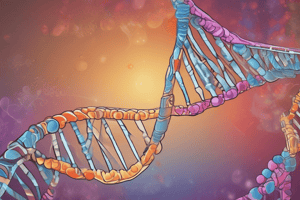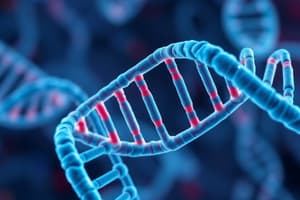Podcast
Questions and Answers
During replication, which enzyme synthesizes the ends of linear chromosomes?
During replication, which enzyme synthesizes the ends of linear chromosomes?
- Telomerase (correct)
- Helicase
- Topoisomerase
- Primase
Which repair system removes incorrect bases with a few surrounding bases and replaces them with the correct bases?
Which repair system removes incorrect bases with a few surrounding bases and replaces them with the correct bases?
- Mismatch repair
- Homologous recombination
- Nucleotide excision repair (correct)
- Non-homologous end-joining
Which repair pathway requires sister chromatids and occurs during S and G2 phase?
Which repair pathway requires sister chromatids and occurs during S and G2 phase?
- Homologous recombination (correct)
- Mismatch repair
- Non-homologous end-joining
- Nucleotide excision repair
Which repair pathway directly ligates broken ends without using a repair template?
Which repair pathway directly ligates broken ends without using a repair template?
Which enzyme removes the RNA primer during DNA replication?
Which enzyme removes the RNA primer during DNA replication?
Which DNA repair mechanism is responsible for removing larger mutations caused by external damage, such as UV damage?
Which DNA repair mechanism is responsible for removing larger mutations caused by external damage, such as UV damage?
Which genetic disease is caused by recessively inherited defects in NER genes and leads to an increased risk of skin cancer?
Which genetic disease is caused by recessively inherited defects in NER genes and leads to an increased risk of skin cancer?
Which DNA repair mechanism corrects errors made during replication by excising and replacing mismatched bases?
Which DNA repair mechanism corrects errors made during replication by excising and replacing mismatched bases?
Which enzyme is responsible for unwinding the double helix during DNA replication?
Which enzyme is responsible for unwinding the double helix during DNA replication?
Which proteins are involved in DNA replication initiation in prokaryotes?
Which proteins are involved in DNA replication initiation in prokaryotes?
Which direction is the leading strand synthesized during DNA replication?
Which direction is the leading strand synthesized during DNA replication?
Which enzyme removes RNA primers and replaces them with DNA during DNA replication?
Which enzyme removes RNA primers and replaces them with DNA during DNA replication?
Which enzyme is responsible for synthesizing a short RNA primer during DNA replication?
Which enzyme is responsible for synthesizing a short RNA primer during DNA replication?
Which protein binds to single-stranded DNA created by helicase during DNA replication initiation?
Which protein binds to single-stranded DNA created by helicase during DNA replication initiation?
Which enzyme removes RNA primers and replaces them with DNA during DNA replication?
Which enzyme removes RNA primers and replaces them with DNA during DNA replication?
Which enzyme is responsible for removing supercoils in the DNA double helix during DNA replication initiation?
Which enzyme is responsible for removing supercoils in the DNA double helix during DNA replication initiation?
Which repair system recognizes mis-incorporated bases, removes them from DNA, and replaces them with the correct bases?
Which repair system recognizes mis-incorporated bases, removes them from DNA, and replaces them with the correct bases?
Which DNA repair mechanism corrects errors made during replication by excising and replacing mismatched bases?
Which DNA repair mechanism corrects errors made during replication by excising and replacing mismatched bases?
Which repair pathway requires sister chromatids and occurs during S and G2 phase?
Which repair pathway requires sister chromatids and occurs during S and G2 phase?
Which repair system removes incorrect bases with a few surrounding bases, which are replaced with the correct bases using a DNA polymerase and the template DNA?
Which repair system removes incorrect bases with a few surrounding bases, which are replaced with the correct bases using a DNA polymerase and the template DNA?
Which genetic disease is caused by recessively inherited defects in NER genes and leads to an increased risk of skin cancer?
Which genetic disease is caused by recessively inherited defects in NER genes and leads to an increased risk of skin cancer?
Which repair pathway requires sister chromatids and occurs during S and G2 phase?
Which repair pathway requires sister chromatids and occurs during S and G2 phase?
Which repair pathway directly ligates broken ends without using a repair template?
Which repair pathway directly ligates broken ends without using a repair template?
Which DNA polymerase has proofreading capability in the 3’ to 5’ direction exonuclease activity?
Which DNA polymerase has proofreading capability in the 3’ to 5’ direction exonuclease activity?
Which DNA repair pathway is responsible for removing small mutations and errors made during replication by excising and replacing mismatched bases?
Which DNA repair pathway is responsible for removing small mutations and errors made during replication by excising and replacing mismatched bases?
Which DNA repair pathway is responsible for removing larger mutations caused by external damage, such as UV damage, by removing the damaged section, filling the gap, and sealing the strand?
Which DNA repair pathway is responsible for removing larger mutations caused by external damage, such as UV damage, by removing the damaged section, filling the gap, and sealing the strand?
Which genetic disease is caused by recessively inherited defects in NER genes and leads to an increased risk of skin cancer due to the accumulation of mutations?
Which genetic disease is caused by recessively inherited defects in NER genes and leads to an increased risk of skin cancer due to the accumulation of mutations?
Which enzyme is responsible for removing RNA primers and replacing them with DNA during DNA replication?
Which enzyme is responsible for removing RNA primers and replacing them with DNA during DNA replication?
Which repair pathway directly ligates broken ends without using a repair template?
Which repair pathway directly ligates broken ends without using a repair template?
Which genetic disease is caused by recessively inherited defects in NER genes and leads to an increased risk of skin cancer?
Which genetic disease is caused by recessively inherited defects in NER genes and leads to an increased risk of skin cancer?
Which direction is the leading strand synthesized during DNA replication?
Which direction is the leading strand synthesized during DNA replication?
Which enzyme is responsible for unwinding the double helix during DNA replication?
Which enzyme is responsible for unwinding the double helix during DNA replication?
Which protein binds to single-stranded DNA created by helicase during DNA replication initiation?
Which protein binds to single-stranded DNA created by helicase during DNA replication initiation?
Which enzyme removes RNA primers and replaces them with DNA during DNA replication?
Which enzyme removes RNA primers and replaces them with DNA during DNA replication?
Which enzyme is responsible for removing the RNA primer during DNA replication?
Which enzyme is responsible for removing the RNA primer during DNA replication?
Which repair pathway requires sister chromatids and occurs during S and G2 phase?
Which repair pathway requires sister chromatids and occurs during S and G2 phase?
Which repair system recognizes mis-incorporated bases, removes them from DNA, and replaces them with the correct bases?
Which repair system recognizes mis-incorporated bases, removes them from DNA, and replaces them with the correct bases?
Which genetic disease is caused by recessively inherited defects in NER genes and leads to an increased risk of skin cancer?
Which genetic disease is caused by recessively inherited defects in NER genes and leads to an increased risk of skin cancer?
Which repair system is responsible for removing incorrect bases with a few surrounding bases and replacing them with the correct bases using a DNA polymerase and the template DNA?
Which repair system is responsible for removing incorrect bases with a few surrounding bases and replacing them with the correct bases using a DNA polymerase and the template DNA?
During DNA replication, which enzyme synthesizes a short RNA primer that is necessary for DNA synthesis to begin?
During DNA replication, which enzyme synthesizes a short RNA primer that is necessary for DNA synthesis to begin?
Which repair pathway requires sister chromatids and occurs during the S and G2 phases of the cell cycle?
Which repair pathway requires sister chromatids and occurs during the S and G2 phases of the cell cycle?
Which repair pathway directly ligates broken ends without using a repair template?
Which repair pathway directly ligates broken ends without using a repair template?
Flashcards
Telomerase
Telomerase
An enzyme that synthesizes the ends of linear chromosomes during replication.
Mismatch Repair
Mismatch Repair
A process that removes incorrect bases from DNA and replaces them with correct bases.
Homologous Recombination
Homologous Recombination
Repair pathway that requires sister chromatids during S and G2 phase.
Non-Homologous End Joining
Non-Homologous End Joining
Signup and view all the flashcards
RNase
RNase
Signup and view all the flashcards
Nucleotide Excision Repair (NER)
Nucleotide Excision Repair (NER)
Signup and view all the flashcards
Xeroderma Pigmentosum
Xeroderma Pigmentosum
Signup and view all the flashcards
Helicase
Helicase
Signup and view all the flashcards
DnaA and oriC
DnaA and oriC
Signup and view all the flashcards
Leading Strand
Leading Strand
Signup and view all the flashcards
DNA Polymerase I
DNA Polymerase I
Signup and view all the flashcards
Primase
Primase
Signup and view all the flashcards
SSB Protein
SSB Protein
Signup and view all the flashcards
Topoisomerase
Topoisomerase
Signup and view all the flashcards
3’ to 5’ Exonuclease Activity
3’ to 5’ Exonuclease Activity
Signup and view all the flashcards
Nucleotide Removal in NER
Nucleotide Removal in NER
Signup and view all the flashcards
Small Mutation Repair
Small Mutation Repair
Signup and view all the flashcards
DNA Damage
DNA Damage
Signup and view all the flashcards
S and G2 Phase
S and G2 Phase
Signup and view all the flashcards
Recessive Inheritance
Recessive Inheritance
Signup and view all the flashcards
Excision
Excision
Signup and view all the flashcards
Proofreading
Proofreading
Signup and view all the flashcards
Repair Template
Repair Template
Signup and view all the flashcards
Skin Cancer
Skin Cancer
Signup and view all the flashcards
External Damage
External Damage
Signup and view all the flashcards
Correct Base Replacement
Correct Base Replacement
Signup and view all the flashcards
Study Notes
DNA Replication and Repair
- Telomerase synthesizes the ends of linear chromosomes during replication.
- Mismatch repair removes incorrect bases with a few surrounding bases and replaces them with the correct bases.
- Homologous recombination repair pathway requires sister chromatids and occurs during S and G2 phase.
- Non-homologous end joining repair pathway directly ligates broken ends without using a repair template.
- RNase removes the RNA primer during DNA replication.
- Nucleotide excision repair (NER) is responsible for removing larger mutations caused by external damage, such as UV damage.
- Xeroderma pigmentosum is a genetic disease caused by recessively inherited defects in NER genes and leads to an increased risk of skin cancer.
- Mismatch repair corrects errors made during replication by excising and replacing mismatched bases.
- Helicase is responsible for unwinding the double helix during DNA replication.
- DnaA and oriC proteins are involved in DNA replication initiation in prokaryotes.
- The leading strand is synthesized in the 5' to 3' direction during DNA replication.
- DNA polymerase I removes RNA primers and replaces them with DNA during DNA replication.
- Primase is responsible for synthesizing a short RNA primer during DNA replication.
- SSB (single-strand binding) protein binds to single-stranded DNA created by helicase during DNA replication initiation.
- Topoisomerase is responsible for removing supercoils in the DNA double helix during DNA replication initiation.
- Mismatch repair recognizes mis-incorporated bases, removes them from DNA, and replaces them with the correct bases.
- NER is responsible for removing larger mutations caused by external damage, such as UV damage, by removing the damaged section, filling the gap, and sealing the strand.
- DNA polymerase I has proofreading capability in the 3’ to 5’ direction exonuclease activity.
- Mismatch repair is responsible for removing small mutations and errors made during replication by excising and replacing mismatched bases.
Studying That Suits You
Use AI to generate personalized quizzes and flashcards to suit your learning preferences.




